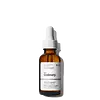What's inside
What's inside
 Key Ingredients
Key Ingredients

 Benefits
Benefits

 Concerns
Concerns

 Ingredients Side-by-side
Ingredients Side-by-side

Water
Skin ConditioningPropylene Glycol
HumectantGlycerin
HumectantPhenoxyethanol
PreservativeCarbomer
Emulsion StabilisingPEG-40 Hydrogenated Castor Oil
EmulsifyingCaprylic/Capric Triglyceride
MaskingCamellia Sinensis Leaf Extract
AntimicrobialMethyl Methacrylate Crosspolymer
Polyglutamic Acid
Skin ConditioningTetrasodium EDTA
Retinol
Skin ConditioningHydrogenated Lecithin
EmulsifyingEthylhexylglycerin
Skin ConditioningCholesterol
EmollientBiosaccharide Gum-1
HumectantTocopheryl Acetate
AntioxidantRubus Idaeus Fruit Extract
AstringentBHT
AntioxidantPunica Granatum Extract
AstringentButylene Glycol
HumectantPhaseolus Radiatus Seed Extract
Skin ConditioningBHA
AntioxidantAvena Sativa Meal Extract
SoothingPalmitoyl Hexapeptide-12
Skin ConditioningWater, Propylene Glycol, Glycerin, Phenoxyethanol, Carbomer, PEG-40 Hydrogenated Castor Oil, Caprylic/Capric Triglyceride, Camellia Sinensis Leaf Extract, Methyl Methacrylate Crosspolymer, Polyglutamic Acid, Tetrasodium EDTA, Retinol, Hydrogenated Lecithin, Ethylhexylglycerin, Cholesterol, Biosaccharide Gum-1, Tocopheryl Acetate, Rubus Idaeus Fruit Extract, BHT, Punica Granatum Extract, Butylene Glycol, Phaseolus Radiatus Seed Extract, BHA, Avena Sativa Meal Extract, Palmitoyl Hexapeptide-12
 Reviews
Reviews

Ingredients Explained
These ingredients are found in both products.
Ingredients higher up in an ingredient list are typically present in a larger amount.
BHT is a synthetic antioxidant and preservative.
As an antioxidant, it helps your body fight off free-radicals. Free-radicals are molecules that may damage your skin cells.
As a preservative, it is used to stabilize products and prevent them from degrading. Specifically, BHT prevents degradation from oxidation.
The concerns related to BHT come from oral studies; this ingredient is currently allowed for use by both the FDA and EU.
However, it was recently restricted for use in the UK as of April 2024.
Learn more about BHTThis ingredient is an emollient, solvent, and texture enhancer. It is considered a skin-softener by helping the skin prevent moisture loss.
It helps thicken a product's formula and makes it easier to spread by dissolving clumping compounds.
Caprylic Triglyceride is made by combining glycerin with coconut oil, forming a clear liquid.
While there is an assumption Caprylic Triglyceride can clog pores due to it being derived from coconut oil, there is no research supporting this.
Learn more about Caprylic/Capric TriglycerideRetinol is a gold-standard ingredient for anti-aging. It is a form of Vitamin A and belongs to the class of retinoids that also includes tretinoin.
Why is retinol famous?
It has the most scientific studies backing up its skin benefits out of all the non-prescription ingredients.
Retinol is proven to:
This is why retinol is effective at removing wrinkles, fading dark spots, treating acne, and reducing the appearance of pores.
Studies show retinol is less effective when exposed to UV. Be sure to look for appropriate packaging to keep your retinol potent (similar to Vitamin C).
Using retinol or any retinoids will increase sun-sensitivity in the first few months. Though studies show retinoids increase your skin's natural SPF with continuous use, it is best to always wear sunscreen and sun-protection.
We recommend speaking with a medical professional about using this ingredient during pregnancy.
Retinol may cause irritation in some people, so be sure to patch test. Experts recommend 'ramping up' retinol use: start using this ingredient once a week and work up to using it daily.
Read about Tretinoin
Learn more about Retinol